Equality, Diversity and Inclusion in Childcare: A Comprehensive Report
VerifiedAdded on 2022/12/23
|12
|3740
|31
Report
AI Summary
This report examines equality, diversity, and inclusion in the context of working with children and young people. It begins by defining key terms like equality, diversity, and inclusion, and then explores relevant legislation such as the Human Rights Act, Every Child Matters Act, and Education Act. The report analyzes school policies on equality, diversity, and inclusion, and discusses how a culturally rich school environment can benefit all children. Task 2 delves into the social and medical models of disability, explains terms like participation, tokenism, stereotyping, prejudice, and direct discrimination, and analyzes discriminatory practices and barriers to participation. Task 3 focuses on inclusive practices within a school environment, examining how a school can be inclusive, how responses should vary based on children's ages, and how to make projects and physical spaces more inclusive. The report provides a comprehensive overview of these critical topics.
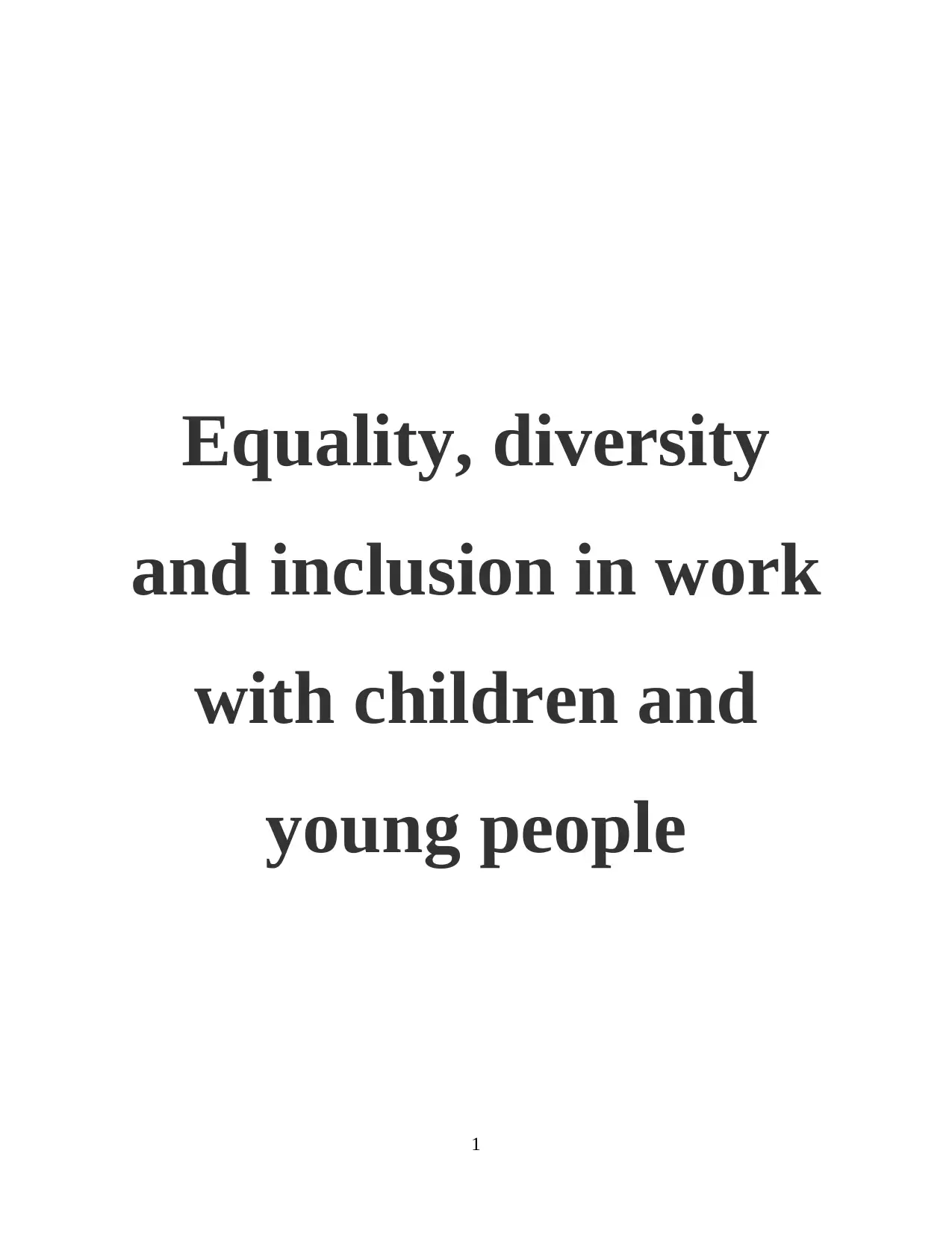
Equality, diversity
and inclusion in work
with children and
young people
1
and inclusion in work
with children and
young people
1
Secure Best Marks with AI Grader
Need help grading? Try our AI Grader for instant feedback on your assignments.
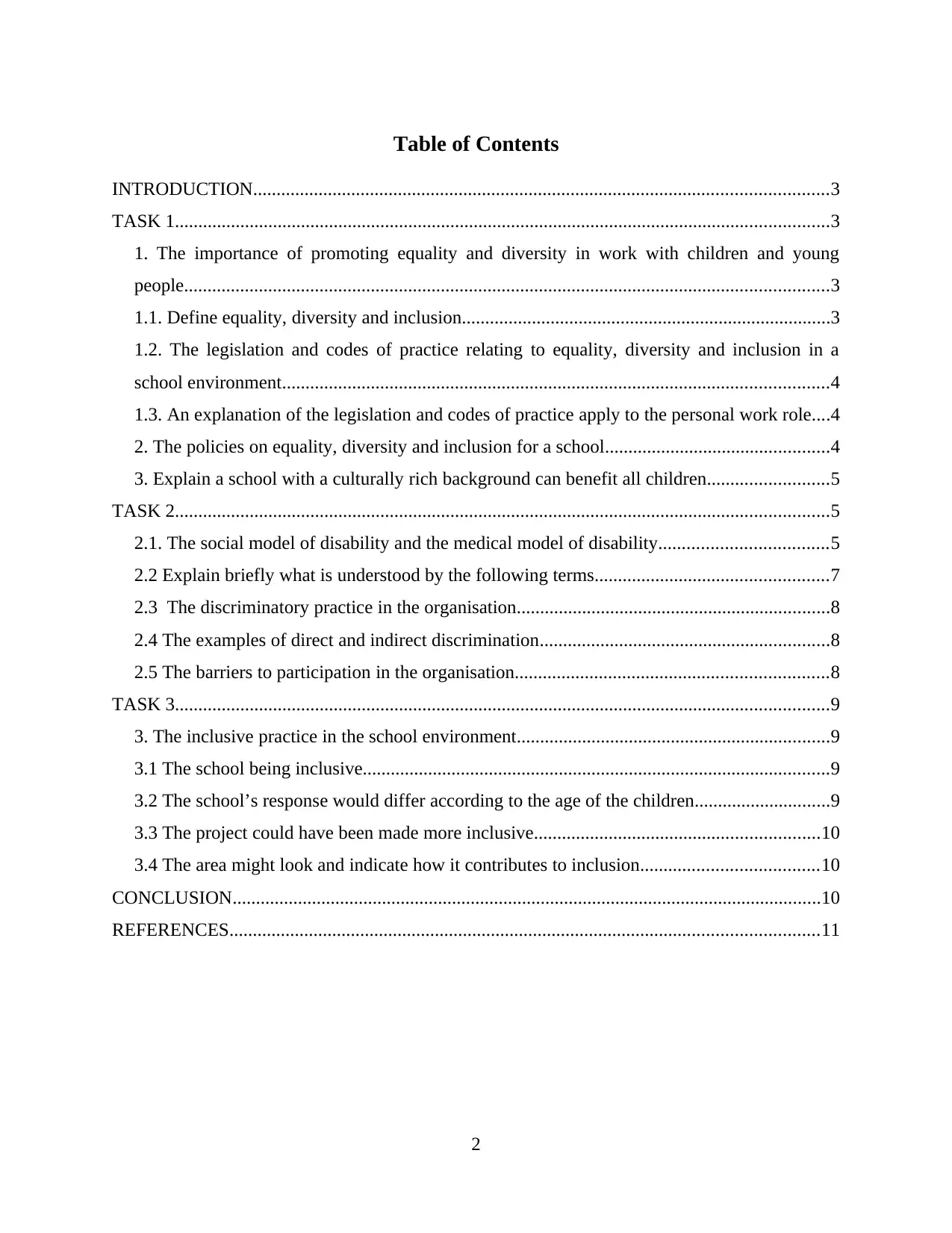
Table of Contents
INTRODUCTION...........................................................................................................................3
TASK 1............................................................................................................................................3
1. The importance of promoting equality and diversity in work with children and young
people..........................................................................................................................................3
1.1. Define equality, diversity and inclusion...............................................................................3
1.2. The legislation and codes of practice relating to equality, diversity and inclusion in a
school environment.....................................................................................................................4
1.3. An explanation of the legislation and codes of practice apply to the personal work role....4
2. The policies on equality, diversity and inclusion for a school................................................4
3. Explain a school with a culturally rich background can benefit all children..........................5
TASK 2............................................................................................................................................5
2.1. The social model of disability and the medical model of disability....................................5
2.2 Explain briefly what is understood by the following terms..................................................7
2.3 The discriminatory practice in the organisation...................................................................8
2.4 The examples of direct and indirect discrimination..............................................................8
2.5 The barriers to participation in the organisation...................................................................8
TASK 3............................................................................................................................................9
3. The inclusive practice in the school environment...................................................................9
3.1 The school being inclusive....................................................................................................9
3.2 The school’s response would differ according to the age of the children.............................9
3.3 The project could have been made more inclusive.............................................................10
3.4 The area might look and indicate how it contributes to inclusion......................................10
CONCLUSION..............................................................................................................................10
REFERENCES..............................................................................................................................11
2
INTRODUCTION...........................................................................................................................3
TASK 1............................................................................................................................................3
1. The importance of promoting equality and diversity in work with children and young
people..........................................................................................................................................3
1.1. Define equality, diversity and inclusion...............................................................................3
1.2. The legislation and codes of practice relating to equality, diversity and inclusion in a
school environment.....................................................................................................................4
1.3. An explanation of the legislation and codes of practice apply to the personal work role....4
2. The policies on equality, diversity and inclusion for a school................................................4
3. Explain a school with a culturally rich background can benefit all children..........................5
TASK 2............................................................................................................................................5
2.1. The social model of disability and the medical model of disability....................................5
2.2 Explain briefly what is understood by the following terms..................................................7
2.3 The discriminatory practice in the organisation...................................................................8
2.4 The examples of direct and indirect discrimination..............................................................8
2.5 The barriers to participation in the organisation...................................................................8
TASK 3............................................................................................................................................9
3. The inclusive practice in the school environment...................................................................9
3.1 The school being inclusive....................................................................................................9
3.2 The school’s response would differ according to the age of the children.............................9
3.3 The project could have been made more inclusive.............................................................10
3.4 The area might look and indicate how it contributes to inclusion......................................10
CONCLUSION..............................................................................................................................10
REFERENCES..............................................................................................................................11
2
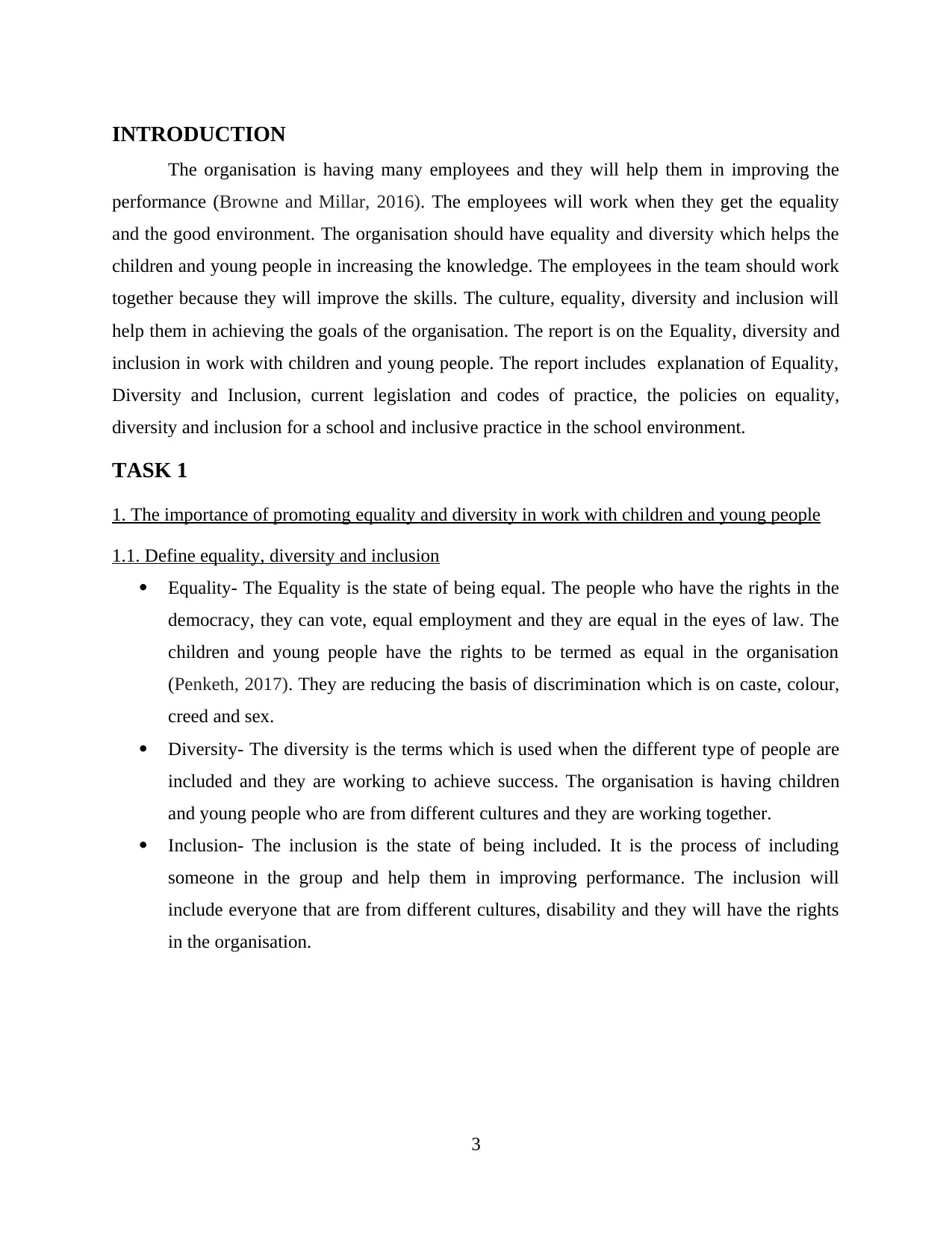
INTRODUCTION
The organisation is having many employees and they will help them in improving the
performance (Browne and Millar, 2016). The employees will work when they get the equality
and the good environment. The organisation should have equality and diversity which helps the
children and young people in increasing the knowledge. The employees in the team should work
together because they will improve the skills. The culture, equality, diversity and inclusion will
help them in achieving the goals of the organisation. The report is on the Equality, diversity and
inclusion in work with children and young people. The report includes explanation of Equality,
Diversity and Inclusion, current legislation and codes of practice, the policies on equality,
diversity and inclusion for a school and inclusive practice in the school environment.
TASK 1
1. The importance of promoting equality and diversity in work with children and young people
1.1. Define equality, diversity and inclusion
Equality- The Equality is the state of being equal. The people who have the rights in the
democracy, they can vote, equal employment and they are equal in the eyes of law. The
children and young people have the rights to be termed as equal in the organisation
(Penketh, 2017). They are reducing the basis of discrimination which is on caste, colour,
creed and sex.
Diversity- The diversity is the terms which is used when the different type of people are
included and they are working to achieve success. The organisation is having children
and young people who are from different cultures and they are working together.
Inclusion- The inclusion is the state of being included. It is the process of including
someone in the group and help them in improving performance. The inclusion will
include everyone that are from different cultures, disability and they will have the rights
in the organisation.
3
The organisation is having many employees and they will help them in improving the
performance (Browne and Millar, 2016). The employees will work when they get the equality
and the good environment. The organisation should have equality and diversity which helps the
children and young people in increasing the knowledge. The employees in the team should work
together because they will improve the skills. The culture, equality, diversity and inclusion will
help them in achieving the goals of the organisation. The report is on the Equality, diversity and
inclusion in work with children and young people. The report includes explanation of Equality,
Diversity and Inclusion, current legislation and codes of practice, the policies on equality,
diversity and inclusion for a school and inclusive practice in the school environment.
TASK 1
1. The importance of promoting equality and diversity in work with children and young people
1.1. Define equality, diversity and inclusion
Equality- The Equality is the state of being equal. The people who have the rights in the
democracy, they can vote, equal employment and they are equal in the eyes of law. The
children and young people have the rights to be termed as equal in the organisation
(Penketh, 2017). They are reducing the basis of discrimination which is on caste, colour,
creed and sex.
Diversity- The diversity is the terms which is used when the different type of people are
included and they are working to achieve success. The organisation is having children
and young people who are from different cultures and they are working together.
Inclusion- The inclusion is the state of being included. It is the process of including
someone in the group and help them in improving performance. The inclusion will
include everyone that are from different cultures, disability and they will have the rights
in the organisation.
3
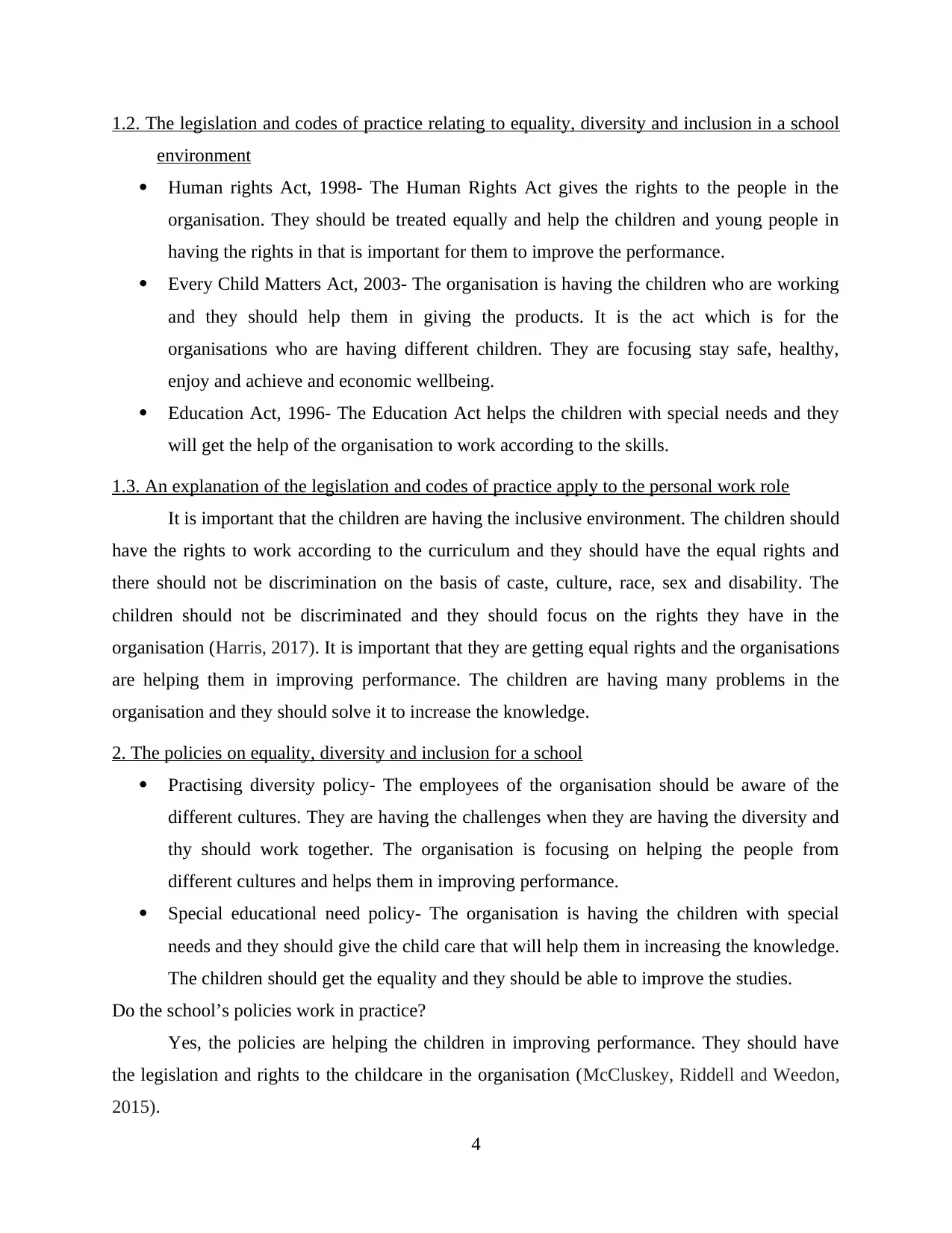
1.2. The legislation and codes of practice relating to equality, diversity and inclusion in a school
environment
Human rights Act, 1998- The Human Rights Act gives the rights to the people in the
organisation. They should be treated equally and help the children and young people in
having the rights in that is important for them to improve the performance.
Every Child Matters Act, 2003- The organisation is having the children who are working
and they should help them in giving the products. It is the act which is for the
organisations who are having different children. They are focusing stay safe, healthy,
enjoy and achieve and economic wellbeing.
Education Act, 1996- The Education Act helps the children with special needs and they
will get the help of the organisation to work according to the skills.
1.3. An explanation of the legislation and codes of practice apply to the personal work role
It is important that the children are having the inclusive environment. The children should
have the rights to work according to the curriculum and they should have the equal rights and
there should not be discrimination on the basis of caste, culture, race, sex and disability. The
children should not be discriminated and they should focus on the rights they have in the
organisation (Harris, 2017). It is important that they are getting equal rights and the organisations
are helping them in improving performance. The children are having many problems in the
organisation and they should solve it to increase the knowledge.
2. The policies on equality, diversity and inclusion for a school
Practising diversity policy- The employees of the organisation should be aware of the
different cultures. They are having the challenges when they are having the diversity and
thy should work together. The organisation is focusing on helping the people from
different cultures and helps them in improving performance.
Special educational need policy- The organisation is having the children with special
needs and they should give the child care that will help them in increasing the knowledge.
The children should get the equality and they should be able to improve the studies.
Do the school’s policies work in practice?
Yes, the policies are helping the children in improving performance. They should have
the legislation and rights to the childcare in the organisation (McCluskey, Riddell and Weedon,
2015).
4
environment
Human rights Act, 1998- The Human Rights Act gives the rights to the people in the
organisation. They should be treated equally and help the children and young people in
having the rights in that is important for them to improve the performance.
Every Child Matters Act, 2003- The organisation is having the children who are working
and they should help them in giving the products. It is the act which is for the
organisations who are having different children. They are focusing stay safe, healthy,
enjoy and achieve and economic wellbeing.
Education Act, 1996- The Education Act helps the children with special needs and they
will get the help of the organisation to work according to the skills.
1.3. An explanation of the legislation and codes of practice apply to the personal work role
It is important that the children are having the inclusive environment. The children should
have the rights to work according to the curriculum and they should have the equal rights and
there should not be discrimination on the basis of caste, culture, race, sex and disability. The
children should not be discriminated and they should focus on the rights they have in the
organisation (Harris, 2017). It is important that they are getting equal rights and the organisations
are helping them in improving performance. The children are having many problems in the
organisation and they should solve it to increase the knowledge.
2. The policies on equality, diversity and inclusion for a school
Practising diversity policy- The employees of the organisation should be aware of the
different cultures. They are having the challenges when they are having the diversity and
thy should work together. The organisation is focusing on helping the people from
different cultures and helps them in improving performance.
Special educational need policy- The organisation is having the children with special
needs and they should give the child care that will help them in increasing the knowledge.
The children should get the equality and they should be able to improve the studies.
Do the school’s policies work in practice?
Yes, the policies are helping the children in improving performance. They should have
the legislation and rights to the childcare in the organisation (McCluskey, Riddell and Weedon,
2015).
4
Secure Best Marks with AI Grader
Need help grading? Try our AI Grader for instant feedback on your assignments.
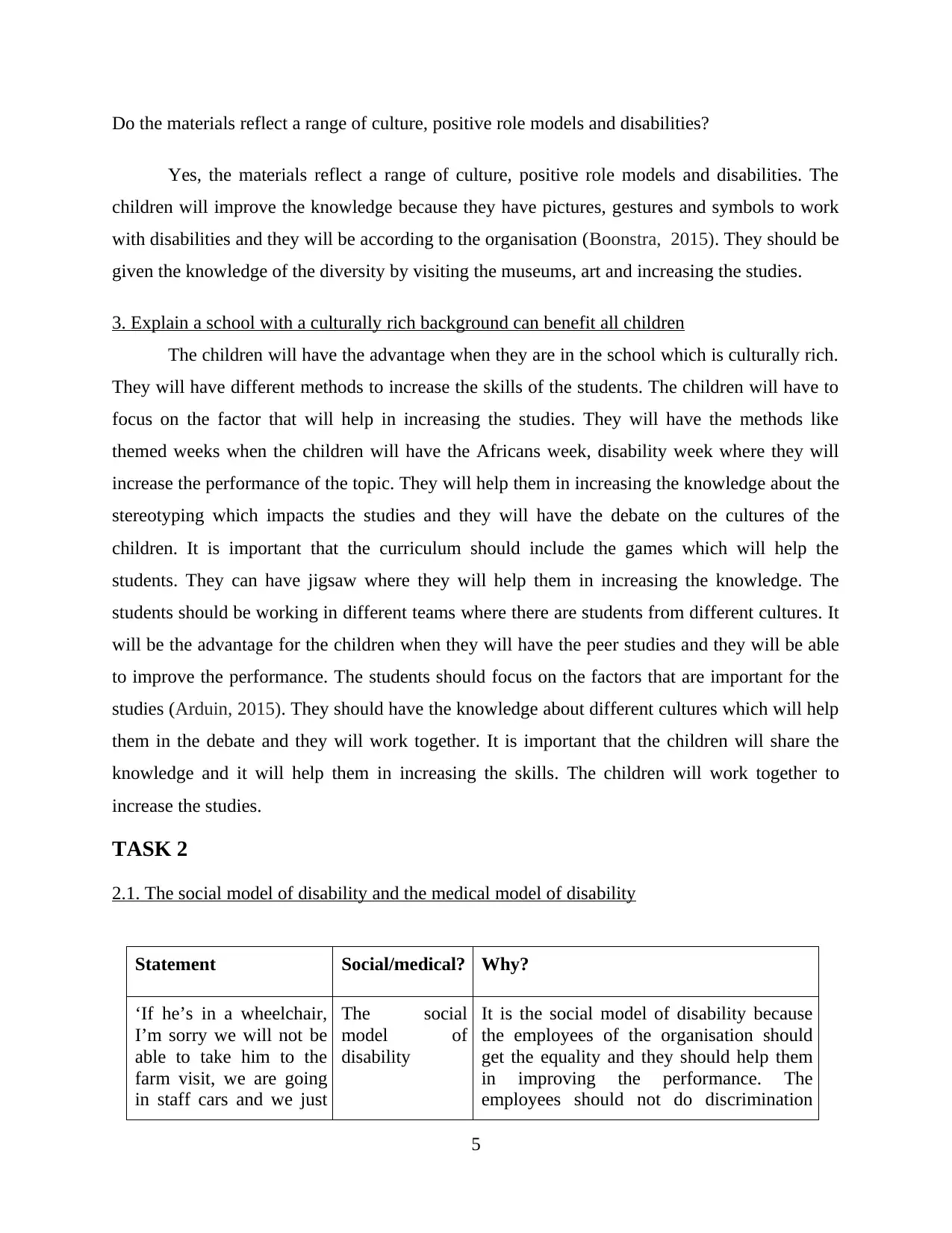
Do the materials reflect a range of culture, positive role models and disabilities?
Yes, the materials reflect a range of culture, positive role models and disabilities. The
children will improve the knowledge because they have pictures, gestures and symbols to work
with disabilities and they will be according to the organisation (Boonstra, 2015). They should be
given the knowledge of the diversity by visiting the museums, art and increasing the studies.
3. Explain a school with a culturally rich background can benefit all children
The children will have the advantage when they are in the school which is culturally rich.
They will have different methods to increase the skills of the students. The children will have to
focus on the factor that will help in increasing the studies. They will have the methods like
themed weeks when the children will have the Africans week, disability week where they will
increase the performance of the topic. They will help them in increasing the knowledge about the
stereotyping which impacts the studies and they will have the debate on the cultures of the
children. It is important that the curriculum should include the games which will help the
students. They can have jigsaw where they will help them in increasing the knowledge. The
students should be working in different teams where there are students from different cultures. It
will be the advantage for the children when they will have the peer studies and they will be able
to improve the performance. The students should focus on the factors that are important for the
studies (Arduin, 2015). They should have the knowledge about different cultures which will help
them in the debate and they will work together. It is important that the children will share the
knowledge and it will help them in increasing the skills. The children will work together to
increase the studies.
TASK 2
2.1. The social model of disability and the medical model of disability
Statement Social/medical? Why?
‘If he’s in a wheelchair,
I’m sorry we will not be
able to take him to the
farm visit, we are going
in staff cars and we just
The social
model of
disability
It is the social model of disability because
the employees of the organisation should
get the equality and they should help them
in improving the performance. The
employees should not do discrimination
5
Yes, the materials reflect a range of culture, positive role models and disabilities. The
children will improve the knowledge because they have pictures, gestures and symbols to work
with disabilities and they will be according to the organisation (Boonstra, 2015). They should be
given the knowledge of the diversity by visiting the museums, art and increasing the studies.
3. Explain a school with a culturally rich background can benefit all children
The children will have the advantage when they are in the school which is culturally rich.
They will have different methods to increase the skills of the students. The children will have to
focus on the factor that will help in increasing the studies. They will have the methods like
themed weeks when the children will have the Africans week, disability week where they will
increase the performance of the topic. They will help them in increasing the knowledge about the
stereotyping which impacts the studies and they will have the debate on the cultures of the
children. It is important that the curriculum should include the games which will help the
students. They can have jigsaw where they will help them in increasing the knowledge. The
students should be working in different teams where there are students from different cultures. It
will be the advantage for the children when they will have the peer studies and they will be able
to improve the performance. The students should focus on the factors that are important for the
studies (Arduin, 2015). They should have the knowledge about different cultures which will help
them in the debate and they will work together. It is important that the children will share the
knowledge and it will help them in increasing the skills. The children will work together to
increase the studies.
TASK 2
2.1. The social model of disability and the medical model of disability
Statement Social/medical? Why?
‘If he’s in a wheelchair,
I’m sorry we will not be
able to take him to the
farm visit, we are going
in staff cars and we just
The social
model of
disability
It is the social model of disability because
the employees of the organisation should
get the equality and they should help them
in improving the performance. The
employees should not do discrimination
5
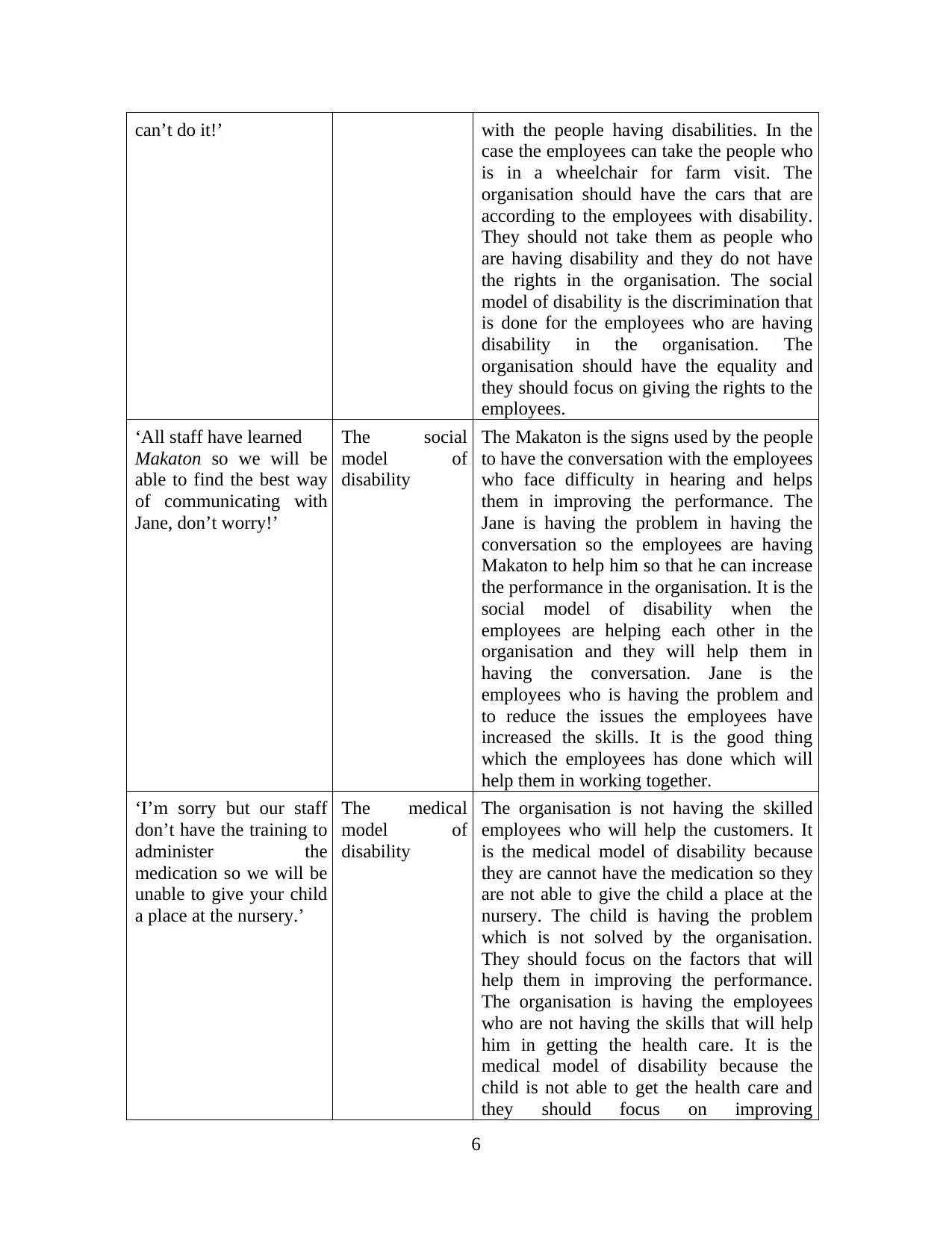
can’t do it!’ with the people having disabilities. In the
case the employees can take the people who
is in a wheelchair for farm visit. The
organisation should have the cars that are
according to the employees with disability.
They should not take them as people who
are having disability and they do not have
the rights in the organisation. The social
model of disability is the discrimination that
is done for the employees who are having
disability in the organisation. The
organisation should have the equality and
they should focus on giving the rights to the
employees.
‘All staff have learned
Makaton so we will be
able to find the best way
of communicating with
Jane, don’t worry!’
The social
model of
disability
The Makaton is the signs used by the people
to have the conversation with the employees
who face difficulty in hearing and helps
them in improving the performance. The
Jane is having the problem in having the
conversation so the employees are having
Makaton to help him so that he can increase
the performance in the organisation. It is the
social model of disability when the
employees are helping each other in the
organisation and they will help them in
having the conversation. Jane is the
employees who is having the problem and
to reduce the issues the employees have
increased the skills. It is the good thing
which the employees has done which will
help them in working together.
‘I’m sorry but our staff
don’t have the training to
administer the
medication so we will be
unable to give your child
a place at the nursery.’
The medical
model of
disability
The organisation is not having the skilled
employees who will help the customers. It
is the medical model of disability because
they are cannot have the medication so they
are not able to give the child a place at the
nursery. The child is having the problem
which is not solved by the organisation.
They should focus on the factors that will
help them in improving the performance.
The organisation is having the employees
who are not having the skills that will help
him in getting the health care. It is the
medical model of disability because the
child is not able to get the health care and
they should focus on improving
6
case the employees can take the people who
is in a wheelchair for farm visit. The
organisation should have the cars that are
according to the employees with disability.
They should not take them as people who
are having disability and they do not have
the rights in the organisation. The social
model of disability is the discrimination that
is done for the employees who are having
disability in the organisation. The
organisation should have the equality and
they should focus on giving the rights to the
employees.
‘All staff have learned
Makaton so we will be
able to find the best way
of communicating with
Jane, don’t worry!’
The social
model of
disability
The Makaton is the signs used by the people
to have the conversation with the employees
who face difficulty in hearing and helps
them in improving the performance. The
Jane is having the problem in having the
conversation so the employees are having
Makaton to help him so that he can increase
the performance in the organisation. It is the
social model of disability when the
employees are helping each other in the
organisation and they will help them in
having the conversation. Jane is the
employees who is having the problem and
to reduce the issues the employees have
increased the skills. It is the good thing
which the employees has done which will
help them in working together.
‘I’m sorry but our staff
don’t have the training to
administer the
medication so we will be
unable to give your child
a place at the nursery.’
The medical
model of
disability
The organisation is not having the skilled
employees who will help the customers. It
is the medical model of disability because
they are cannot have the medication so they
are not able to give the child a place at the
nursery. The child is having the problem
which is not solved by the organisation.
They should focus on the factors that will
help them in improving the performance.
The organisation is having the employees
who are not having the skills that will help
him in getting the health care. It is the
medical model of disability because the
child is not able to get the health care and
they should focus on improving
6
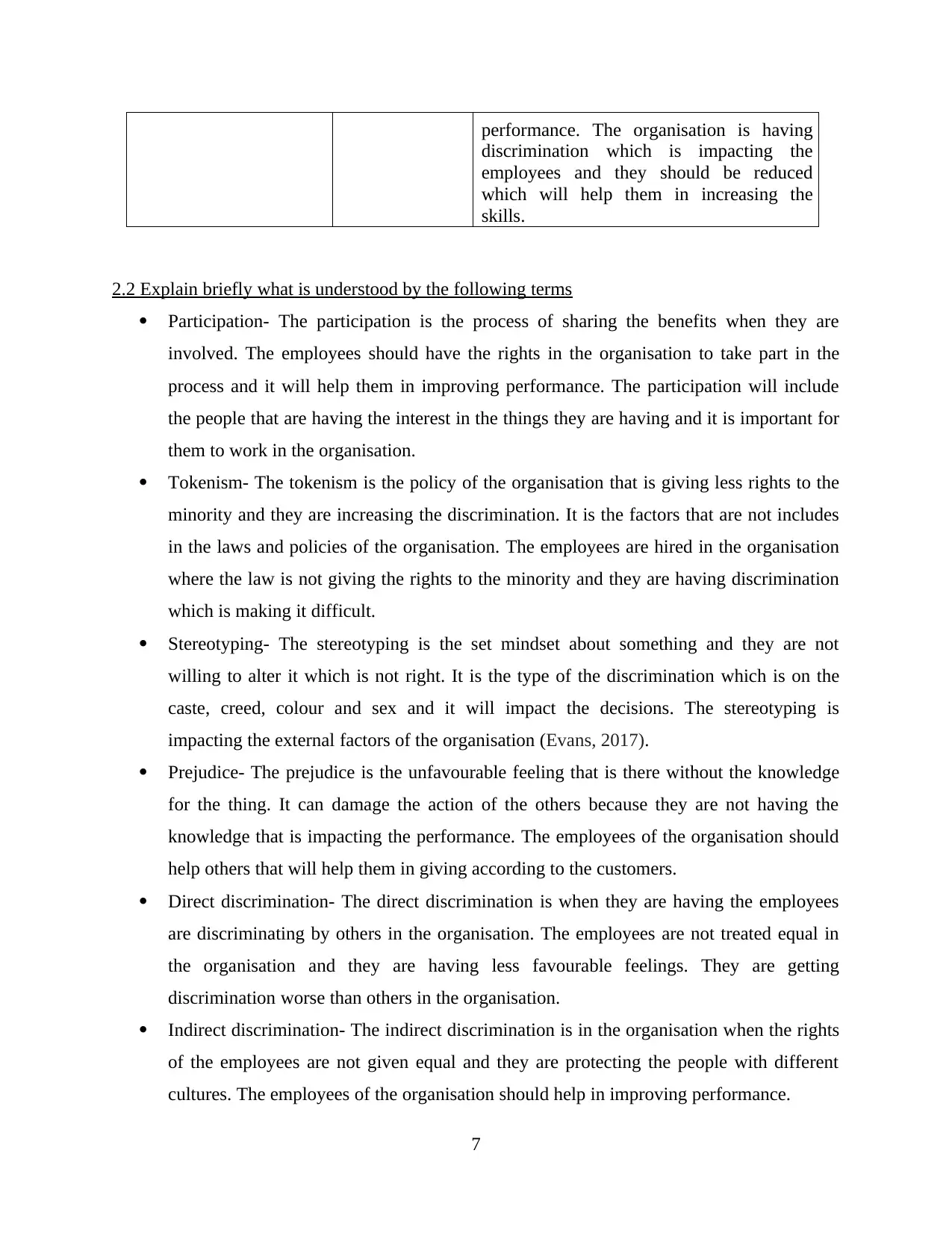
performance. The organisation is having
discrimination which is impacting the
employees and they should be reduced
which will help them in increasing the
skills.
2.2 Explain briefly what is understood by the following terms
Participation- The participation is the process of sharing the benefits when they are
involved. The employees should have the rights in the organisation to take part in the
process and it will help them in improving performance. The participation will include
the people that are having the interest in the things they are having and it is important for
them to work in the organisation.
Tokenism- The tokenism is the policy of the organisation that is giving less rights to the
minority and they are increasing the discrimination. It is the factors that are not includes
in the laws and policies of the organisation. The employees are hired in the organisation
where the law is not giving the rights to the minority and they are having discrimination
which is making it difficult.
Stereotyping- The stereotyping is the set mindset about something and they are not
willing to alter it which is not right. It is the type of the discrimination which is on the
caste, creed, colour and sex and it will impact the decisions. The stereotyping is
impacting the external factors of the organisation (Evans, 2017).
Prejudice- The prejudice is the unfavourable feeling that is there without the knowledge
for the thing. It can damage the action of the others because they are not having the
knowledge that is impacting the performance. The employees of the organisation should
help others that will help them in giving according to the customers.
Direct discrimination- The direct discrimination is when they are having the employees
are discriminating by others in the organisation. The employees are not treated equal in
the organisation and they are having less favourable feelings. They are getting
discrimination worse than others in the organisation.
Indirect discrimination- The indirect discrimination is in the organisation when the rights
of the employees are not given equal and they are protecting the people with different
cultures. The employees of the organisation should help in improving performance.
7
discrimination which is impacting the
employees and they should be reduced
which will help them in increasing the
skills.
2.2 Explain briefly what is understood by the following terms
Participation- The participation is the process of sharing the benefits when they are
involved. The employees should have the rights in the organisation to take part in the
process and it will help them in improving performance. The participation will include
the people that are having the interest in the things they are having and it is important for
them to work in the organisation.
Tokenism- The tokenism is the policy of the organisation that is giving less rights to the
minority and they are increasing the discrimination. It is the factors that are not includes
in the laws and policies of the organisation. The employees are hired in the organisation
where the law is not giving the rights to the minority and they are having discrimination
which is making it difficult.
Stereotyping- The stereotyping is the set mindset about something and they are not
willing to alter it which is not right. It is the type of the discrimination which is on the
caste, creed, colour and sex and it will impact the decisions. The stereotyping is
impacting the external factors of the organisation (Evans, 2017).
Prejudice- The prejudice is the unfavourable feeling that is there without the knowledge
for the thing. It can damage the action of the others because they are not having the
knowledge that is impacting the performance. The employees of the organisation should
help others that will help them in giving according to the customers.
Direct discrimination- The direct discrimination is when they are having the employees
are discriminating by others in the organisation. The employees are not treated equal in
the organisation and they are having less favourable feelings. They are getting
discrimination worse than others in the organisation.
Indirect discrimination- The indirect discrimination is in the organisation when the rights
of the employees are not given equal and they are protecting the people with different
cultures. The employees of the organisation should help in improving performance.
7
Paraphrase This Document
Need a fresh take? Get an instant paraphrase of this document with our AI Paraphraser
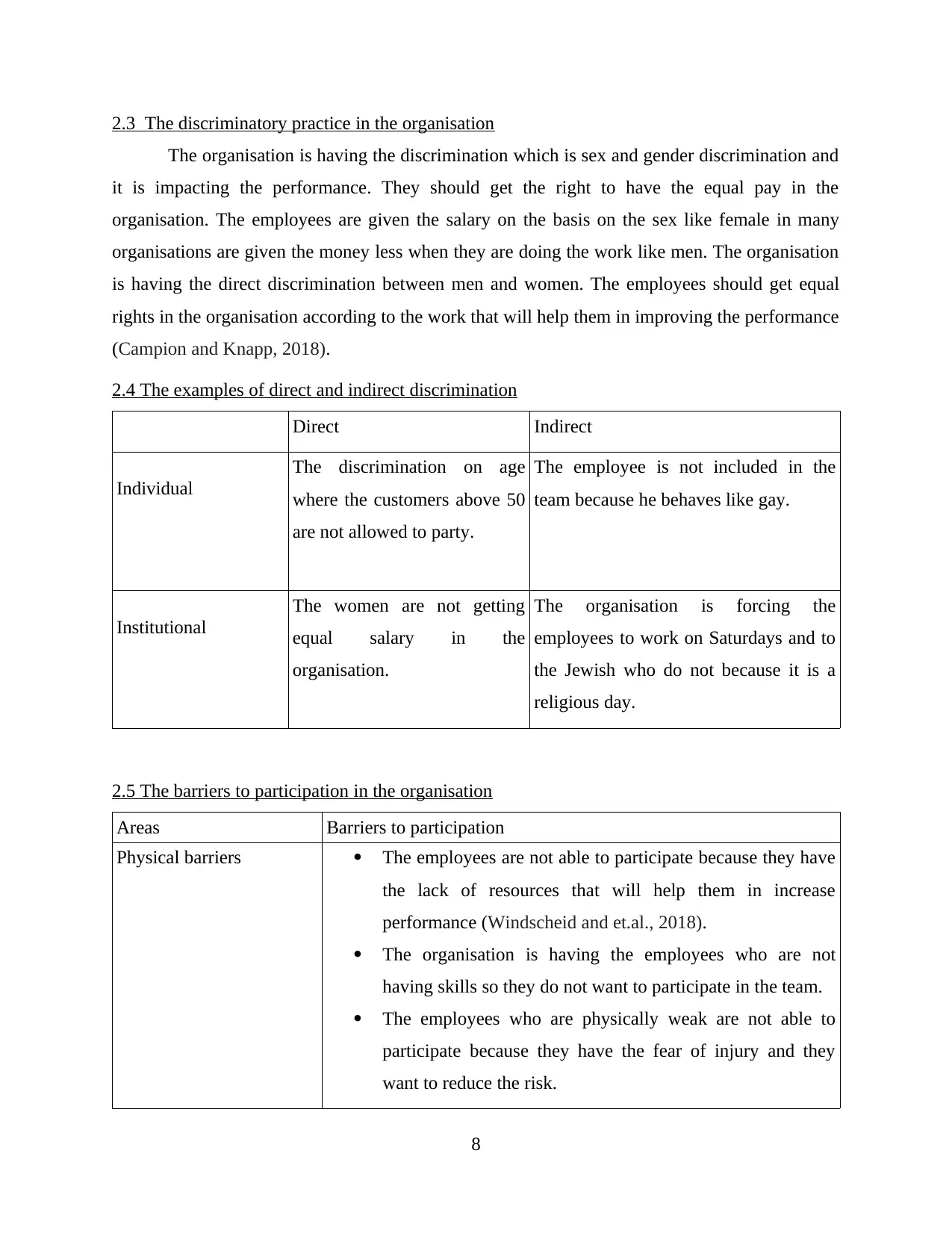
2.3 The discriminatory practice in the organisation
The organisation is having the discrimination which is sex and gender discrimination and
it is impacting the performance. They should get the right to have the equal pay in the
organisation. The employees are given the salary on the basis on the sex like female in many
organisations are given the money less when they are doing the work like men. The organisation
is having the direct discrimination between men and women. The employees should get equal
rights in the organisation according to the work that will help them in improving the performance
(Campion and Knapp, 2018).
2.4 The examples of direct and indirect discrimination
Direct Indirect
Individual
The discrimination on age
where the customers above 50
are not allowed to party.
The employee is not included in the
team because he behaves like gay.
Institutional
The women are not getting
equal salary in the
organisation.
The organisation is forcing the
employees to work on Saturdays and to
the Jewish who do not because it is a
religious day.
2.5 The barriers to participation in the organisation
Areas Barriers to participation
Physical barriers The employees are not able to participate because they have
the lack of resources that will help them in increase
performance (Windscheid and et.al., 2018).
The organisation is having the employees who are not
having skills so they do not want to participate in the team.
The employees who are physically weak are not able to
participate because they have the fear of injury and they
want to reduce the risk.
8
The organisation is having the discrimination which is sex and gender discrimination and
it is impacting the performance. They should get the right to have the equal pay in the
organisation. The employees are given the salary on the basis on the sex like female in many
organisations are given the money less when they are doing the work like men. The organisation
is having the direct discrimination between men and women. The employees should get equal
rights in the organisation according to the work that will help them in improving the performance
(Campion and Knapp, 2018).
2.4 The examples of direct and indirect discrimination
Direct Indirect
Individual
The discrimination on age
where the customers above 50
are not allowed to party.
The employee is not included in the
team because he behaves like gay.
Institutional
The women are not getting
equal salary in the
organisation.
The organisation is forcing the
employees to work on Saturdays and to
the Jewish who do not because it is a
religious day.
2.5 The barriers to participation in the organisation
Areas Barriers to participation
Physical barriers The employees are not able to participate because they have
the lack of resources that will help them in increase
performance (Windscheid and et.al., 2018).
The organisation is having the employees who are not
having skills so they do not want to participate in the team.
The employees who are physically weak are not able to
participate because they have the fear of injury and they
want to reduce the risk.
8
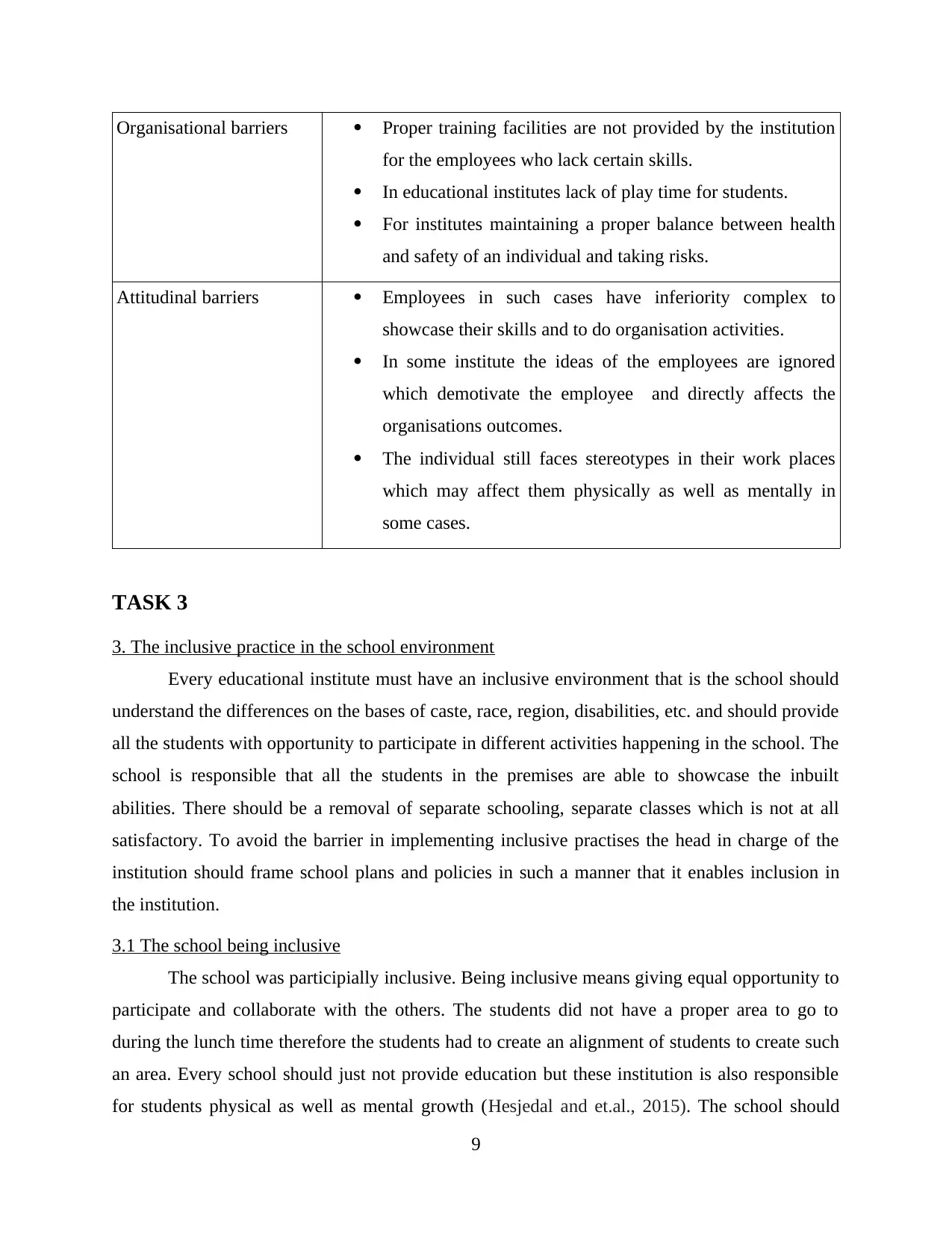
Organisational barriers Proper training facilities are not provided by the institution
for the employees who lack certain skills.
In educational institutes lack of play time for students.
For institutes maintaining a proper balance between health
and safety of an individual and taking risks.
Attitudinal barriers Employees in such cases have inferiority complex to
showcase their skills and to do organisation activities.
In some institute the ideas of the employees are ignored
which demotivate the employee and directly affects the
organisations outcomes.
The individual still faces stereotypes in their work places
which may affect them physically as well as mentally in
some cases.
TASK 3
3. The inclusive practice in the school environment
Every educational institute must have an inclusive environment that is the school should
understand the differences on the bases of caste, race, region, disabilities, etc. and should provide
all the students with opportunity to participate in different activities happening in the school. The
school is responsible that all the students in the premises are able to showcase the inbuilt
abilities. There should be a removal of separate schooling, separate classes which is not at all
satisfactory. To avoid the barrier in implementing inclusive practises the head in charge of the
institution should frame school plans and policies in such a manner that it enables inclusion in
the institution.
3.1 The school being inclusive
The school was participially inclusive. Being inclusive means giving equal opportunity to
participate and collaborate with the others. The students did not have a proper area to go to
during the lunch time therefore the students had to create an alignment of students to create such
an area. Every school should just not provide education but these institution is also responsible
for students physical as well as mental growth (Hesjedal and et.al., 2015). The school should
9
for the employees who lack certain skills.
In educational institutes lack of play time for students.
For institutes maintaining a proper balance between health
and safety of an individual and taking risks.
Attitudinal barriers Employees in such cases have inferiority complex to
showcase their skills and to do organisation activities.
In some institute the ideas of the employees are ignored
which demotivate the employee and directly affects the
organisations outcomes.
The individual still faces stereotypes in their work places
which may affect them physically as well as mentally in
some cases.
TASK 3
3. The inclusive practice in the school environment
Every educational institute must have an inclusive environment that is the school should
understand the differences on the bases of caste, race, region, disabilities, etc. and should provide
all the students with opportunity to participate in different activities happening in the school. The
school is responsible that all the students in the premises are able to showcase the inbuilt
abilities. There should be a removal of separate schooling, separate classes which is not at all
satisfactory. To avoid the barrier in implementing inclusive practises the head in charge of the
institution should frame school plans and policies in such a manner that it enables inclusion in
the institution.
3.1 The school being inclusive
The school was participially inclusive. Being inclusive means giving equal opportunity to
participate and collaborate with the others. The students did not have a proper area to go to
during the lunch time therefore the students had to create an alignment of students to create such
an area. Every school should just not provide education but these institution is also responsible
for students physical as well as mental growth (Hesjedal and et.al., 2015). The school should
9
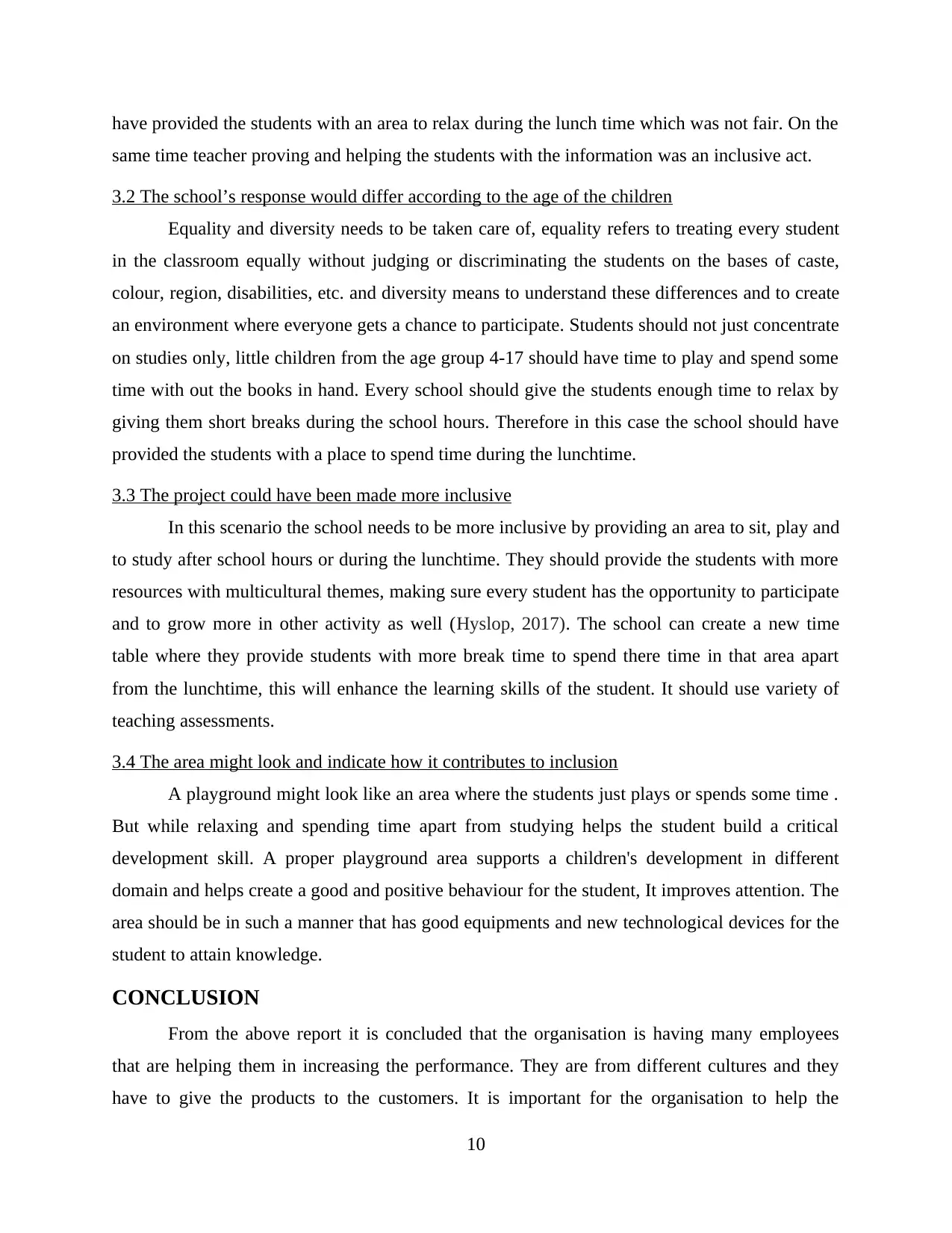
have provided the students with an area to relax during the lunch time which was not fair. On the
same time teacher proving and helping the students with the information was an inclusive act.
3.2 The school’s response would differ according to the age of the children
Equality and diversity needs to be taken care of, equality refers to treating every student
in the classroom equally without judging or discriminating the students on the bases of caste,
colour, region, disabilities, etc. and diversity means to understand these differences and to create
an environment where everyone gets a chance to participate. Students should not just concentrate
on studies only, little children from the age group 4-17 should have time to play and spend some
time with out the books in hand. Every school should give the students enough time to relax by
giving them short breaks during the school hours. Therefore in this case the school should have
provided the students with a place to spend time during the lunchtime.
3.3 The project could have been made more inclusive
In this scenario the school needs to be more inclusive by providing an area to sit, play and
to study after school hours or during the lunchtime. They should provide the students with more
resources with multicultural themes, making sure every student has the opportunity to participate
and to grow more in other activity as well (Hyslop, 2017). The school can create a new time
table where they provide students with more break time to spend there time in that area apart
from the lunchtime, this will enhance the learning skills of the student. It should use variety of
teaching assessments.
3.4 The area might look and indicate how it contributes to inclusion
A playground might look like an area where the students just plays or spends some time .
But while relaxing and spending time apart from studying helps the student build a critical
development skill. A proper playground area supports a children's development in different
domain and helps create a good and positive behaviour for the student, It improves attention. The
area should be in such a manner that has good equipments and new technological devices for the
student to attain knowledge.
CONCLUSION
From the above report it is concluded that the organisation is having many employees
that are helping them in increasing the performance. They are from different cultures and they
have to give the products to the customers. It is important for the organisation to help the
10
same time teacher proving and helping the students with the information was an inclusive act.
3.2 The school’s response would differ according to the age of the children
Equality and diversity needs to be taken care of, equality refers to treating every student
in the classroom equally without judging or discriminating the students on the bases of caste,
colour, region, disabilities, etc. and diversity means to understand these differences and to create
an environment where everyone gets a chance to participate. Students should not just concentrate
on studies only, little children from the age group 4-17 should have time to play and spend some
time with out the books in hand. Every school should give the students enough time to relax by
giving them short breaks during the school hours. Therefore in this case the school should have
provided the students with a place to spend time during the lunchtime.
3.3 The project could have been made more inclusive
In this scenario the school needs to be more inclusive by providing an area to sit, play and
to study after school hours or during the lunchtime. They should provide the students with more
resources with multicultural themes, making sure every student has the opportunity to participate
and to grow more in other activity as well (Hyslop, 2017). The school can create a new time
table where they provide students with more break time to spend there time in that area apart
from the lunchtime, this will enhance the learning skills of the student. It should use variety of
teaching assessments.
3.4 The area might look and indicate how it contributes to inclusion
A playground might look like an area where the students just plays or spends some time .
But while relaxing and spending time apart from studying helps the student build a critical
development skill. A proper playground area supports a children's development in different
domain and helps create a good and positive behaviour for the student, It improves attention. The
area should be in such a manner that has good equipments and new technological devices for the
student to attain knowledge.
CONCLUSION
From the above report it is concluded that the organisation is having many employees
that are helping them in increasing the performance. They are from different cultures and they
have to give the products to the customers. It is important for the organisation to help the
10
Secure Best Marks with AI Grader
Need help grading? Try our AI Grader for instant feedback on your assignments.
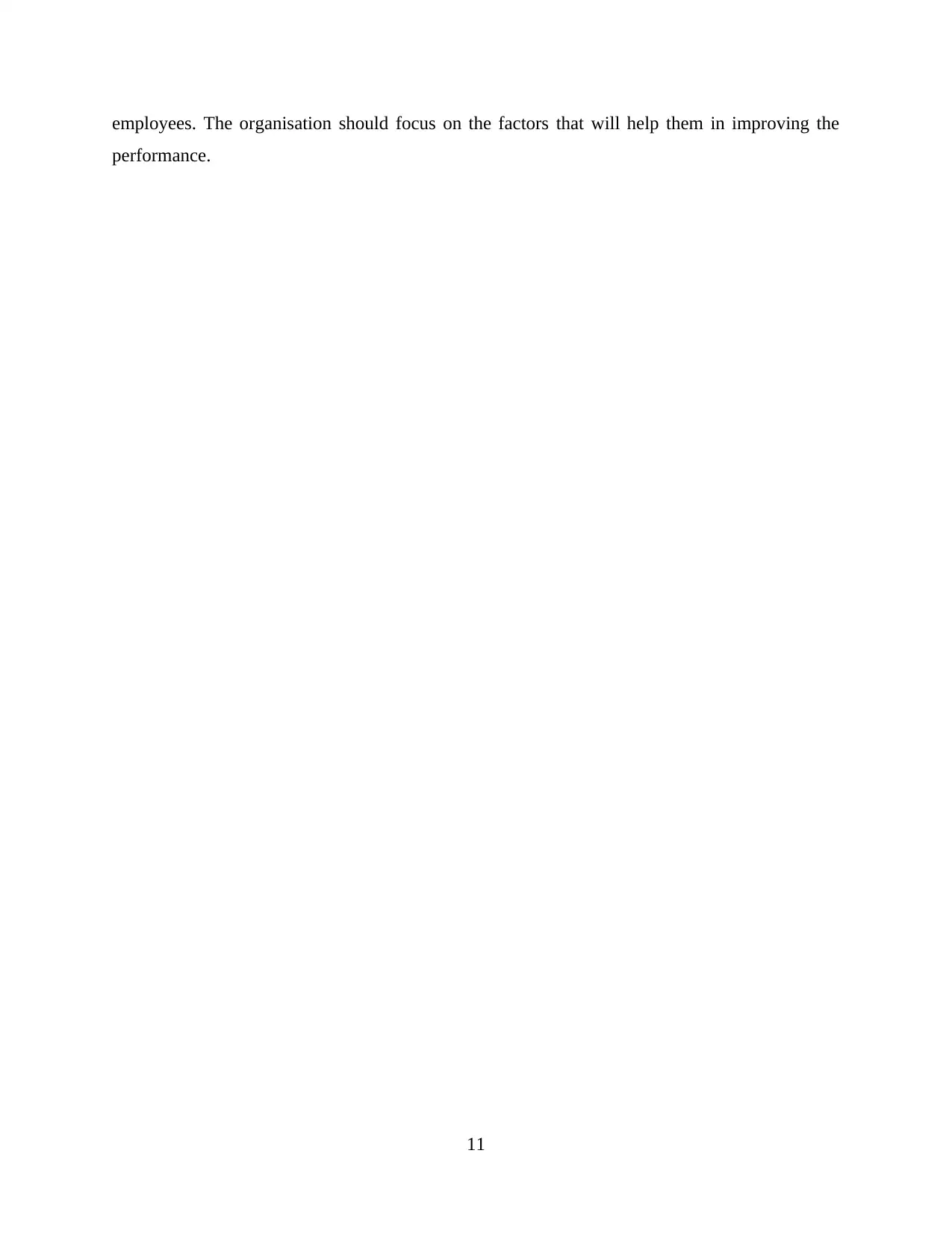
employees. The organisation should focus on the factors that will help them in improving the
performance.
11
performance.
11
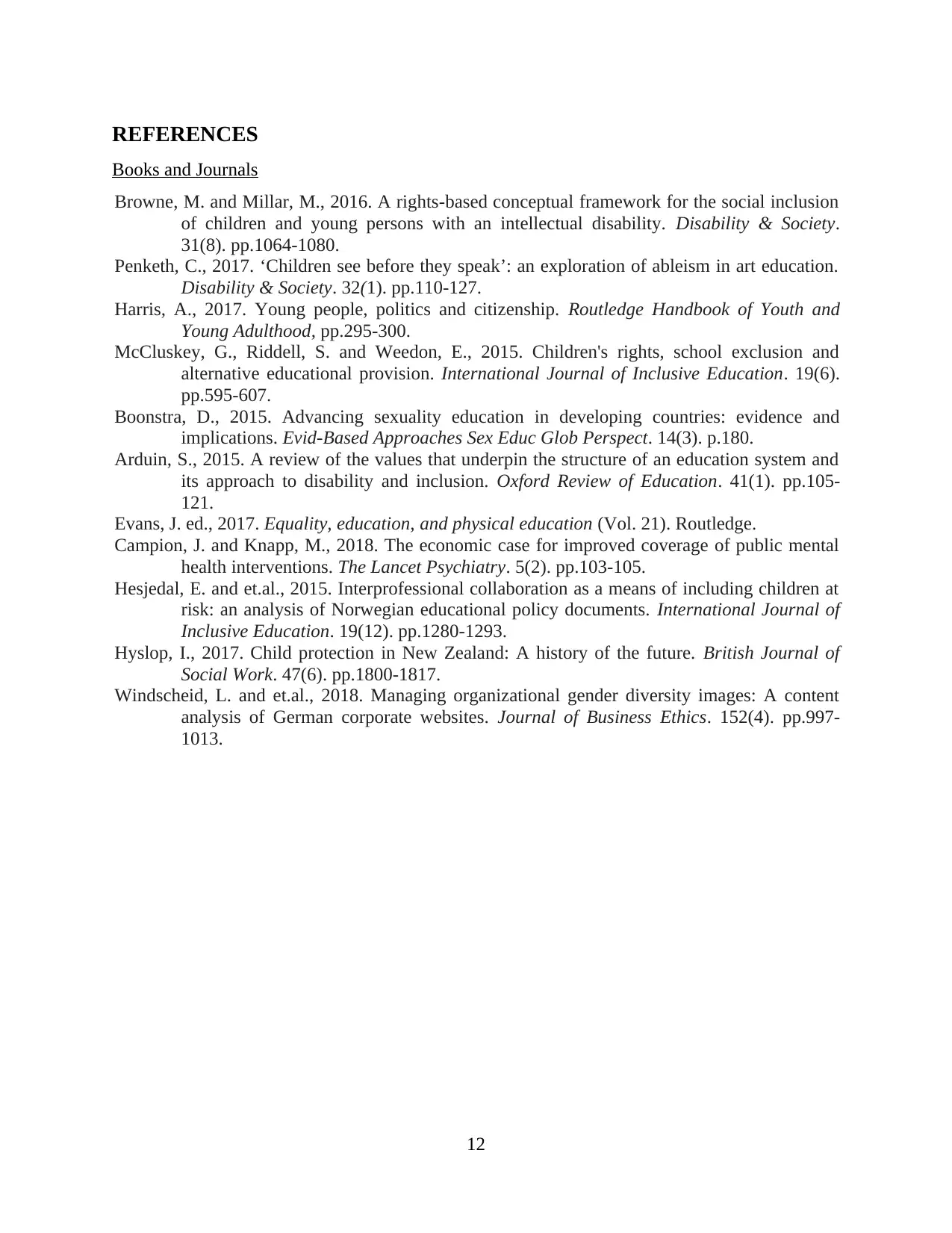
REFERENCES
Books and Journals
Browne, M. and Millar, M., 2016. A rights-based conceptual framework for the social inclusion
of children and young persons with an intellectual disability. Disability & Society.
31(8). pp.1064-1080.
Penketh, C., 2017. ‘Children see before they speak’: an exploration of ableism in art education.
Disability & Society. 32(1). pp.110-127.
Harris, A., 2017. Young people, politics and citizenship. Routledge Handbook of Youth and
Young Adulthood, pp.295-300.
McCluskey, G., Riddell, S. and Weedon, E., 2015. Children's rights, school exclusion and
alternative educational provision. International Journal of Inclusive Education. 19(6).
pp.595-607.
Boonstra, D., 2015. Advancing sexuality education in developing countries: evidence and
implications. Evid-Based Approaches Sex Educ Glob Perspect. 14(3). p.180.
Arduin, S., 2015. A review of the values that underpin the structure of an education system and
its approach to disability and inclusion. Oxford Review of Education. 41(1). pp.105-
121.
Evans, J. ed., 2017. Equality, education, and physical education (Vol. 21). Routledge.
Campion, J. and Knapp, M., 2018. The economic case for improved coverage of public mental
health interventions. The Lancet Psychiatry. 5(2). pp.103-105.
Hesjedal, E. and et.al., 2015. Interprofessional collaboration as a means of including children at
risk: an analysis of Norwegian educational policy documents. International Journal of
Inclusive Education. 19(12). pp.1280-1293.
Hyslop, I., 2017. Child protection in New Zealand: A history of the future. British Journal of
Social Work. 47(6). pp.1800-1817.
Windscheid, L. and et.al., 2018. Managing organizational gender diversity images: A content
analysis of German corporate websites. Journal of Business Ethics. 152(4). pp.997-
1013.
12
Books and Journals
Browne, M. and Millar, M., 2016. A rights-based conceptual framework for the social inclusion
of children and young persons with an intellectual disability. Disability & Society.
31(8). pp.1064-1080.
Penketh, C., 2017. ‘Children see before they speak’: an exploration of ableism in art education.
Disability & Society. 32(1). pp.110-127.
Harris, A., 2017. Young people, politics and citizenship. Routledge Handbook of Youth and
Young Adulthood, pp.295-300.
McCluskey, G., Riddell, S. and Weedon, E., 2015. Children's rights, school exclusion and
alternative educational provision. International Journal of Inclusive Education. 19(6).
pp.595-607.
Boonstra, D., 2015. Advancing sexuality education in developing countries: evidence and
implications. Evid-Based Approaches Sex Educ Glob Perspect. 14(3). p.180.
Arduin, S., 2015. A review of the values that underpin the structure of an education system and
its approach to disability and inclusion. Oxford Review of Education. 41(1). pp.105-
121.
Evans, J. ed., 2017. Equality, education, and physical education (Vol. 21). Routledge.
Campion, J. and Knapp, M., 2018. The economic case for improved coverage of public mental
health interventions. The Lancet Psychiatry. 5(2). pp.103-105.
Hesjedal, E. and et.al., 2015. Interprofessional collaboration as a means of including children at
risk: an analysis of Norwegian educational policy documents. International Journal of
Inclusive Education. 19(12). pp.1280-1293.
Hyslop, I., 2017. Child protection in New Zealand: A history of the future. British Journal of
Social Work. 47(6). pp.1800-1817.
Windscheid, L. and et.al., 2018. Managing organizational gender diversity images: A content
analysis of German corporate websites. Journal of Business Ethics. 152(4). pp.997-
1013.
12
1 out of 12
Related Documents
Your All-in-One AI-Powered Toolkit for Academic Success.
+13062052269
info@desklib.com
Available 24*7 on WhatsApp / Email
![[object Object]](/_next/static/media/star-bottom.7253800d.svg)
Unlock your academic potential
© 2024 | Zucol Services PVT LTD | All rights reserved.





